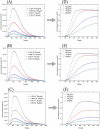A combined experimental and theoretical study on the immunoassay of human immunoglobulin using a quartz crystal microbalance
- PMID: 22163539
- PMCID: PMC3231060
- DOI: 10.3390/s101211498
A combined experimental and theoretical study on the immunoassay of human immunoglobulin using a quartz crystal microbalance
Abstract
We investigate a immunoassay biosensor that employs a Quartz Crystal Microbalance (QCM) to detect the specific binding reaction of the (Human IgG1)-(Anti-Human IgG1) protein pair under physiological conditions. In addition to experiments, a three dimensional time domain finite element method (FEM) was used to perform simulations for the biomolecular binding reaction in microfluidic channels. In particular, we discuss the unsteady convective diffusion in the transportation tube, which conveys the buffer solution containing the analyte molecules into the micro-channel where the QCM sensor lies. It is found that the distribution of the analyte concentration in the tube is strongly affected by the flow field, yielding large discrepancies between the simulations and experimental results. Our analysis shows that the conventional assumption of the analyte concentration in the inlet of the micro-channel being uniform and constant in time is inadequate. In addition, we also show that the commonly used procedure in kinetic analysis for estimating binding rate constants from the experimental data would underestimate these rate constants due to neglected diffusion processes from the inlet to the reaction surface. A calibration procedure is proposed to supplement the basic kinetic analysis, thus yielding better consistency with experiments.
Keywords: Finite Element Method (FEM); Quartz Crystal Microbalance; basic kinetic analysis; biosensor; human IgG1.
Figures






Similar articles
-
A gas-phase amplified quartz crystal microbalance immunosensor based on catalase modified immunoparticles.Analyst. 2015 Feb 21;140(4):1174-81. doi: 10.1039/c4an02061h. Analyst. 2015. PMID: 25519742
-
Real time kinetic analysis of the interaction between immunoglobulin G and histidine using quartz crystal microbalance biosensor in solution.Biosens Bioelectron. 2003 Oct 1;18(11):1419-27. doi: 10.1016/s0956-5663(03)00090-3. Biosens Bioelectron. 2003. PMID: 12896844
-
Real-time multianalyte biosensors based on interference-free multichannel monolithic quartz crystal microbalance.Biosens Bioelectron. 2015 May 15;67:576-81. doi: 10.1016/j.bios.2014.09.047. Epub 2014 Sep 28. Biosens Bioelectron. 2015. PMID: 25307623
-
Wireless-electrodeless quartz-crystal-microbalance biosensors for studying interactions among biomolecules: a review.Proc Jpn Acad Ser B Phys Biol Sci. 2013;89(9):401-17. doi: 10.2183/pjab.89.401. Proc Jpn Acad Ser B Phys Biol Sci. 2013. PMID: 24213205 Free PMC article. Review.
-
A survey of the 2006-2009 quartz crystal microbalance biosensor literature.J Mol Recognit. 2011 Sep-Oct;24(5):754-87. doi: 10.1002/jmr.1117. J Mol Recognit. 2011. PMID: 21812051 Review.
Cited by
-
Improving the binding efficiency of quartz crystal microbalance biosensors by applying the electrothermal effect.Biomicrofluidics. 2014 Oct 15;8(5):054116. doi: 10.1063/1.4898633. eCollection 2014 Sep. Biomicrofluidics. 2014. PMID: 25538808 Free PMC article.
-
Advanced Impedance Spectroscopy for QCM Sensor in Liquid Medium.Sensors (Basel). 2022 Mar 17;22(6):2337. doi: 10.3390/s22062337. Sensors (Basel). 2022. PMID: 35336507 Free PMC article.
-
Diverse applications of electronic-nose technologies in agriculture and forestry.Sensors (Basel). 2013 Feb 8;13(2):2295-348. doi: 10.3390/s130202295. Sensors (Basel). 2013. PMID: 23396191 Free PMC article. Review.
References
-
- Collings AF, Caruso F. Biosensors: Recent advances. Rep Progr Phys. 1997;60:1397–1445.
-
- Sauerbrey GZ. Verwendung von Schwingquarzen zur Wagung dunner Schichten undzur Mikrowagung. Z Phys. 1959;155:206–222.
-
- King WH. Piezoelectric Sorption Detector. Anal Chem. 1964;36:1735–1739.
-
- Thompson M, Arthur CL, Dhaliwal GK. Liquid-Phase Piezoelectric and Acoustic Transmission Studies of Interfacial Immunochemistry. Anal Chem. 1986;58:1206–1209. - PubMed
-
- Hengerer A, Kosslinger C, Decker J, Hauck S, Queitsch I, Wolf H, Dubel S. Determination of Phage Antibody Affinities to Antigen by a Microbalance Sensor System. Biotechniques. 1999;26:956–964. - PubMed
Publication types
MeSH terms
Substances
LinkOut - more resources
Full Text Sources

